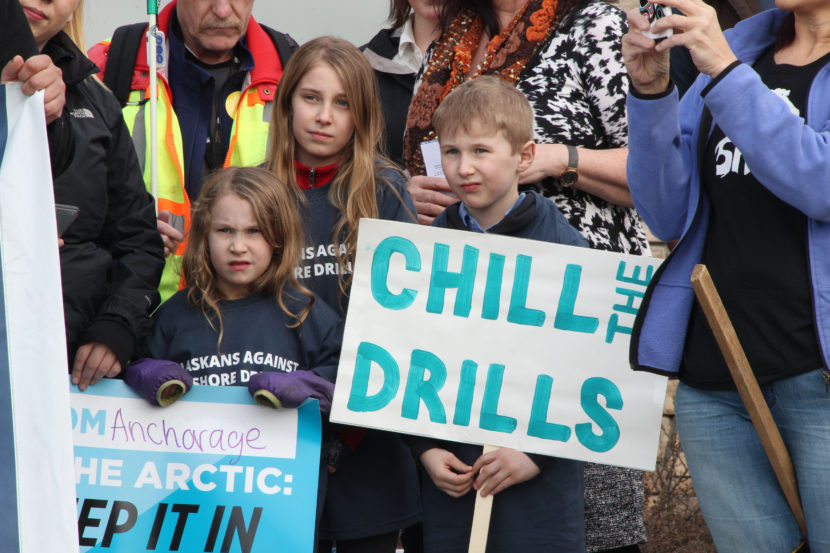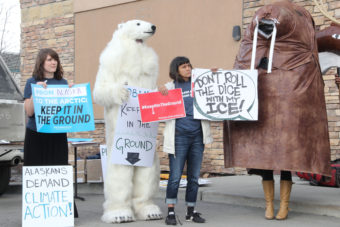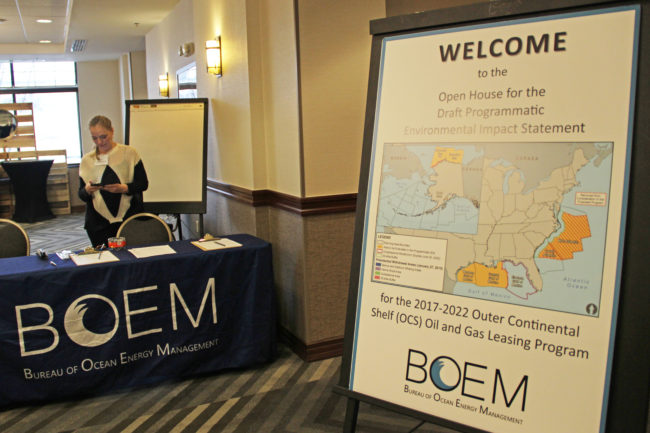
About 70 people — and Frostpaw the Polar Bear — gathered in the parking lot of the Embassy Suites hotel in Midtown Anchorage on Tuesday evening, holding signs that read “Keep it in the ground” and “Chill the drills.”

Inside, the Bureau of Ocean Energy Management, or BOEM, was holding one of 10 public meetings around the state to get input on potential offshore lease sales. The agency wants the public to weigh in on plans for offshore drilling over the next five years. The tentative proposal would allow lease sales in the Arctic Ocean and Cook Inlet.
That plan has drawn opposition from environmentalists, who see their fight as part of a worldwide effort to halt climate change. The bureau’s plan covers the years 2017-2022, and tentatively includes three lease sales in Alaska: in Cook Inlet, and in the Beaufort and Chukchi Seas.
BOEM’s draft environmental impact statement looks at effects on local communities, infrastructure, subsistence, marine mammals and the potential for oil spills.
The one issue it doesn’t address is the one critics are most concerned about.
“We don’t say, if this much oil, for example, is taken out of the ground, it will have this much effect on climate change,” said Jennifer Bosyk a marine biologist with the Bureau. Bosyk said that kind of discussion is left to policymakers.
But Eric Grafe, a staff attorney at the environmental group Earthjustice, called that a major omission.
To reach the climate goals agreed to in Paris last year, he said, the world can’t burn much of the oil that’s already been discovered – let alone any new oil.
“If we burn all the oil we know about, the glass is already overflowing — and we’re pouring more water into the glass,” Grafe said. “That doesn’t make sense.”
There has been no offshore lease sale in Alaska since 2008. The Department of the Interior canceled sales planned for the current cycle after Shell pulled out of the Arctic last September, citing the company’s disappointing results and a lack of other industry interest.
BOEM’s new commenting process led to a somewhat surreal scene at the Embassy Suites. Instead of accepting verbal comments in a town hall-style event, the agency set up stations in a conference room, where members of the public could speak with experts and then record written comments in laptops.

Sergio Acuna came to support more offshore drilling. Acuna works in pipeline maintenance. Like many people in the room, he wore a bright orange sweatshirt with the logo for the Laborers’ International Union of North America, Local 341.
“We, the laborers, we’re the ones who care for our beloved trans-Alaska pipeline,” he said.
Acuna said he thought the protest was great. But at the end of the day, he said, a lot of jobs depend on how much oil is flowing through that pipeline.
“I understand their point of view,” Acuna said. But, he added with a laugh, “My only question for them will be, like, what do they do for work? Because, if there’s no more oil in Alaska, I may have to come up to them and ask them for work.”
BOEM is accepting public comment on its draft environmental impact statement through May 2.
